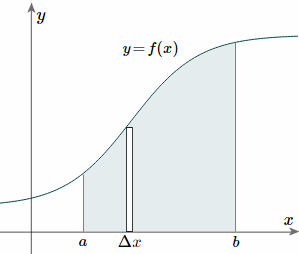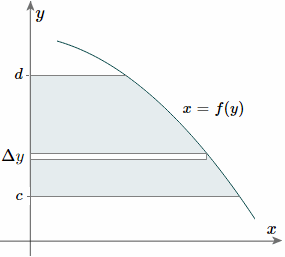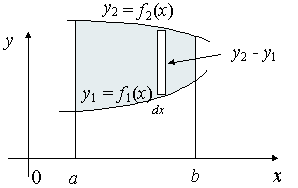Centroid for Curved Areas:
Taking the simple case first, we aim to find the centroid for the area defined by a function f(x), and the vertical lines x = a and x = b as indicated in the following figure.

To find the centroid, we use the same basic idea that we were using for the straight-sided case above. The “typical” rectangle indicated is x units from the y-axis, and it has width Δx (which becomes dx when we integrate) and height y = f(x).
Generalizing from the above rectangular areas case, we multiply these 3 values (x, f(x) and Δx, which will give us the area of each thin rectangle times its distance from the x-axis), then add them. If we do this for infinitesimally small strips, we get the x-coordinates of the centroid using the total moments in the x-direction, given by:

And, considering the moments in the y-direction about the x-axis and re-expressing the function in terms of y, we have:


Notice this time the integration is with respect to y, and the distance of the “typical” rectangle from the x-axis is y units. Also note the lower and upper limits of the integral are c and d, which are on the y-axis.
Of course, there may be rectangular portions we need to consider separately. (I’ve used a different curve for the y case for simplification.)
Alternate method:
Depending on the function, it may be easier to use the following alternative formula for the y-coordinate, which is derived from considering moments in the x-direction (Note the “dx” in the integral, and the upper and lower limits are along the x-axis for this alternate method).

This is true since for our thin strip (width dx), the centroid will be half the distance from the top to the bottom of the strip.
Another advantage of this second formula is there is no need to re-express the function in terms of y.
Centroids for Areas Bounded by 2 Curves:

We extend the simple case given above. The “typical” rectangle indicated has width Δx and height y2 − y1, so the total moments in the x-direction over the total area is given by:

For the y coordinate, we have 2 different ways we can go about it.
Method 1: We take moments about the y-axis and so we’ll need to re-express the expressions x2 and x1 as functions of y.

Method 2: We can also keep everything in terms of x by extending the “Alternate Method” given above:

